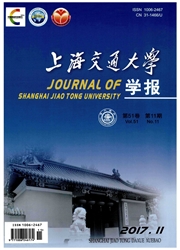

 中文摘要:
中文摘要:
对现有定形复合相变材料的制备方法进行改进,采用"熔融吸附-模压成型"的方法,以硬脂酸(stearic acid,SA)为相变材料,膨胀石墨(expanded graphite,EG)为多孔基体,制备了16种不同参数的样品,并对其进行了微观形貌表征、热物性测试、热稳定性研究及热性能分析。相关研究表明:SEM微观形貌显示样品内部出现致密的石墨片层结构,SA均匀分布在石墨片层中,且压块密度越大,片层结构形态越规则;DSC测试结果显示样品几乎没有过冷度,EG的加入与压块处理对SA本身的相变潜热和相变温度几乎没有影响;Hot Disk测试结果显示EG的加入显著提高了样品的轴向和径向热导率,随着EG含量的增加,径向热导率高达23.77 W·m-1·K-1,发现两个方向上热导率的差异随压块密度的增加而增大,最大相差5.4倍;储/放热循环实验发现压块密度越大、EG含量越低的样品,SA越容易发生泄漏;通过成型密度及质量配比的优化可实现对复合材料的热稳定性调控,发现EG质量分数为25%、密度为950 kg·m-3的样品具有较好的综合性能。与传统定形复合相变材料的成型方法相比,该方法可进一步提高复合相变材料的综合热性能,与纯相变材料相比其热导率可提高130倍以上,且具有简单易操作的特点。
 英文摘要:
英文摘要:
A modified method is proposed to prepare shape-stabilized phase change composites by employing "heating adsorption of liquid stearic acid(SA) into expanded graphite(EG) matrix and compressing stable-shape composite". Sixteen samples with different EG contents and packed densities are prepared using SA as the phase change material and EG as porous matrix. The microstructures, thermal properties and thermal stabilities of different EG/SA samples are analyzed and investigated. Scanning electron microscopy is first used to observe the microstructures of EG/SA samples and the results show that SA is well dispersed into the graphite flakes and the laminar structures become more inerratic with increasing packed density. The data obtained from differential scanning calorimetry show that the EG/SA composites nearly have no supercooling problem. Moreover, the addition of EG and compressing operation have negligible effect on the latent heat and phase change temperature of pure SA. Hot-disk thermal constants analyzer is used to evaluate the effect of EG content and packed density on the thermal conductivity and the anisotropy of the EG/SA samples, including axial and radial thermal conductivity. The results show that both axial and radial thermal conductivity can be enhanced significantly by using the additive of EG, and the radial thermal conductivity is as high as 23.77 W·m-1·K-1. The difference between axial and radial thermal conductivity becomes more remarkable by increasing the packed density, and the largest difference reaches 5.4 times. Finally, the thermal stability of EG/SA samples is evaluated by repeating charging and discharging processes of SA. The samples with relatively high density or low EG content are susceptible to liquid leak. However, the thermal stability of EG/SA composites can be regulated by optimizing the combination of EG content and packed density. The shape-stabilized phase change composites present better comprehensive performance with EG content about 25% and packed density abou
 同期刊论文项目
同期刊论文项目
 同项目期刊论文
同项目期刊论文
 期刊信息
期刊信息
